Time Blocking: The Holy Grail of Getting Stuff Done (Without Pulling Your Hair Out)
Discover the Best Time Blocking App to Maximize Productivity
People often overload their schedules with complex planning solutions, yet many overlook the full potential of a well-utilized calendar to improve productivity. But are you using your calendar to its fullest?
Research shows that structured scheduling, like time blocking, can reduce mental fatigue and improve focus. A study from Georgetown University found that dedicating blocks of time to specific tasks enables "deep work" — uninterrupted, focused time that’s crucial for higher-quality outcomes (Newport, 2016).
In this article, we’ll dive into the benefits of time blocking and recommend the best apps, based on real-life testing of 40 apps, to help you create a productive schedule.
A quick look at the best time blocking apps
- Planyway for Trello, GitHub, and Jira users who need a visual planning tool
- Plan for simplest task scheduling
- Sunsama for daily personal life
- TickTick for to-do lists with integrated time tracking
- Hourstack for detailed time analysis and reporting
- Todoist for users who prefer structured to-do lists
- TimeBloc best for Android users and Mac/iOS users
- Google Calendar best free time blocking app
- Any.do for task management with collaborative options
- ClickUp for personal and team productivity
- Clockify free tool focused on time tracking
- TimeCamp for an overview of time spent on multiple projects
- Fantastical Mac/iOS compatibility with a highly refined interface
- Clockwise to minimize interruptions in your schedule
- TogglTrack for seamless time tracking automation
- Motion AI time blocking app
What is time blocking?
Time blocking is a productivity method where each task, event, and responsibility is scheduled in dedicated time blocks. Instead of keeping open-ended to-do lists, you define exactly what you’ll work on and when. This approach prioritizes tasks and minimizes interruptions, helping you stay focused and achieve more.
Briefly, time blocking requires:
- Listing your tasks.
- Prioritizing them based on importance.
- Estimating time for each task.
- Scheduling them into your day for focused work without distraction.
At the end of each day, review any unfinished tasks and adjust your blocks for the coming days. Research suggests that scheduling in this way reduces the mental load associated with task-switching and helps develop a more accurate sense of time needed for similar future tasks (González & Mark, 2004).
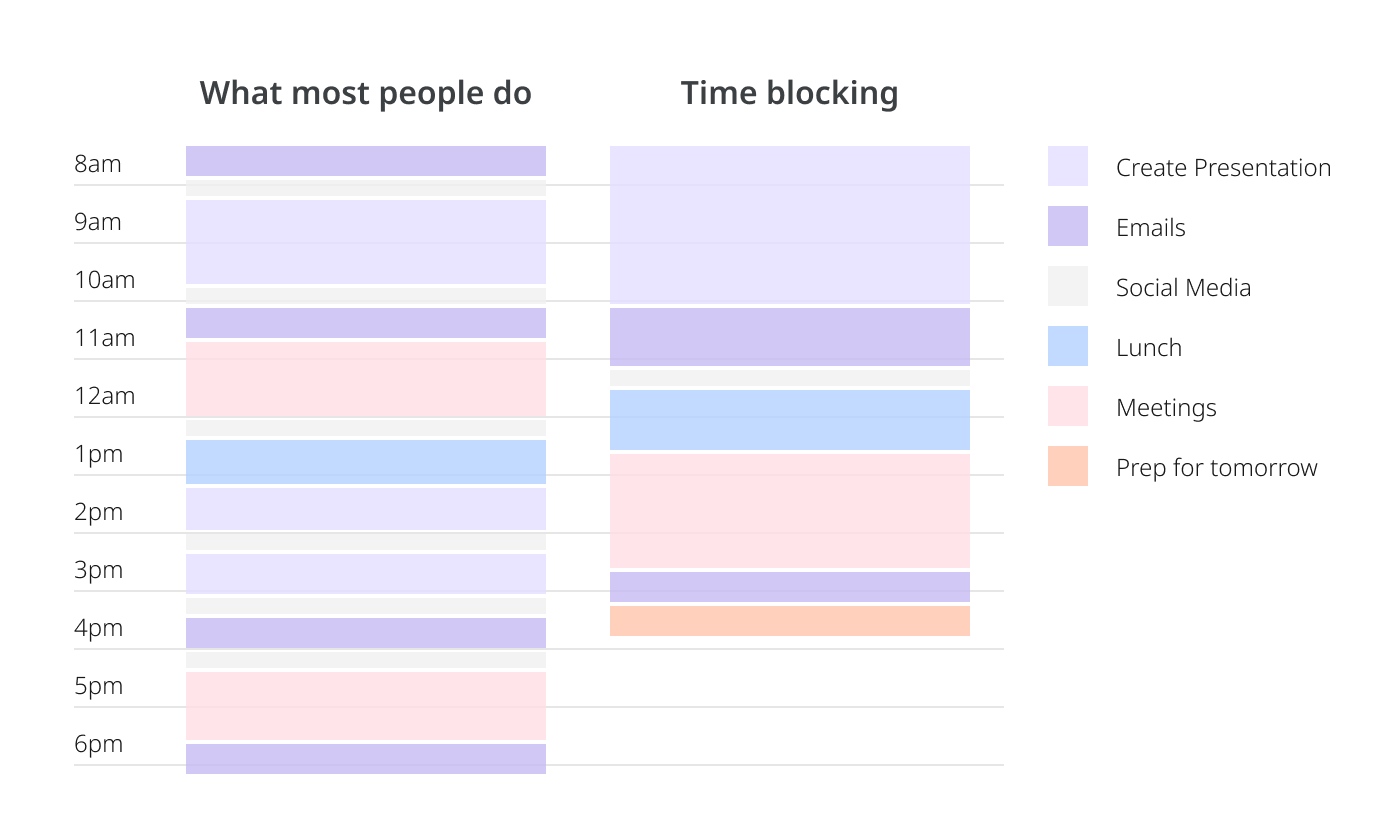
Time blocking for different professions
Time blocking can be a game-changer, but it’s not one-size-fits-all. Some roles, such as customer support or account management, require high flexibility and rapid responses to incoming tasks. While full time blocking may be challenging for these roles, even partial control over scheduling can increase efficiency and reduce burnout.
Best time blocking apps
After testing over 40 popular productivity apps, here are our top choices. Each app was evaluated on usability, unique features, integrations, and overall functionality. We focused on users across varied scenarios — from freelancers to project managers — to ensure each tool’s strengths were highlighted according to real-world productivity needs.
Planyway
Planyway is one of the best tools that combines all you need to schedule work in the easiest and most effective way. It’s the ultimate time-blocking solution that allows you to drag and drop tasks to block time on a calendar or timeline.
Let’s see what you can do with Planyway in more detail:
To distinguish different types of activities, make use of color-coding. This way you may label tasks and filter them as soon as you need it.
In case, you have the hierarchy of tasks, you’ll be happy to hear that Planyway supports subtasks. And the thing is that you not only have them visible inside the parent tasks but may visualize them on the hourly calendar too and use them to block time.
For the tasks that appear in your schedule on a regular basis, we recommend applying the recurrence rule. By doing it, the task will show up on the calendar automatically.
Apart from blocking your time slots with Planyway cards, you can integrate the app with Google Calendar, Outlook, and other external calendars so that you have a full picture of your schedule.
What’s more, you can create time blocks the other way using Time Tracking:
Simply by starting the timer you can track time on tasks and focus on deep work. If you forget to hit the start button, no worries, manual logging time is available too. Also, you may leave notes to time entries in order to clarify how exactly the time was spent.
Plan
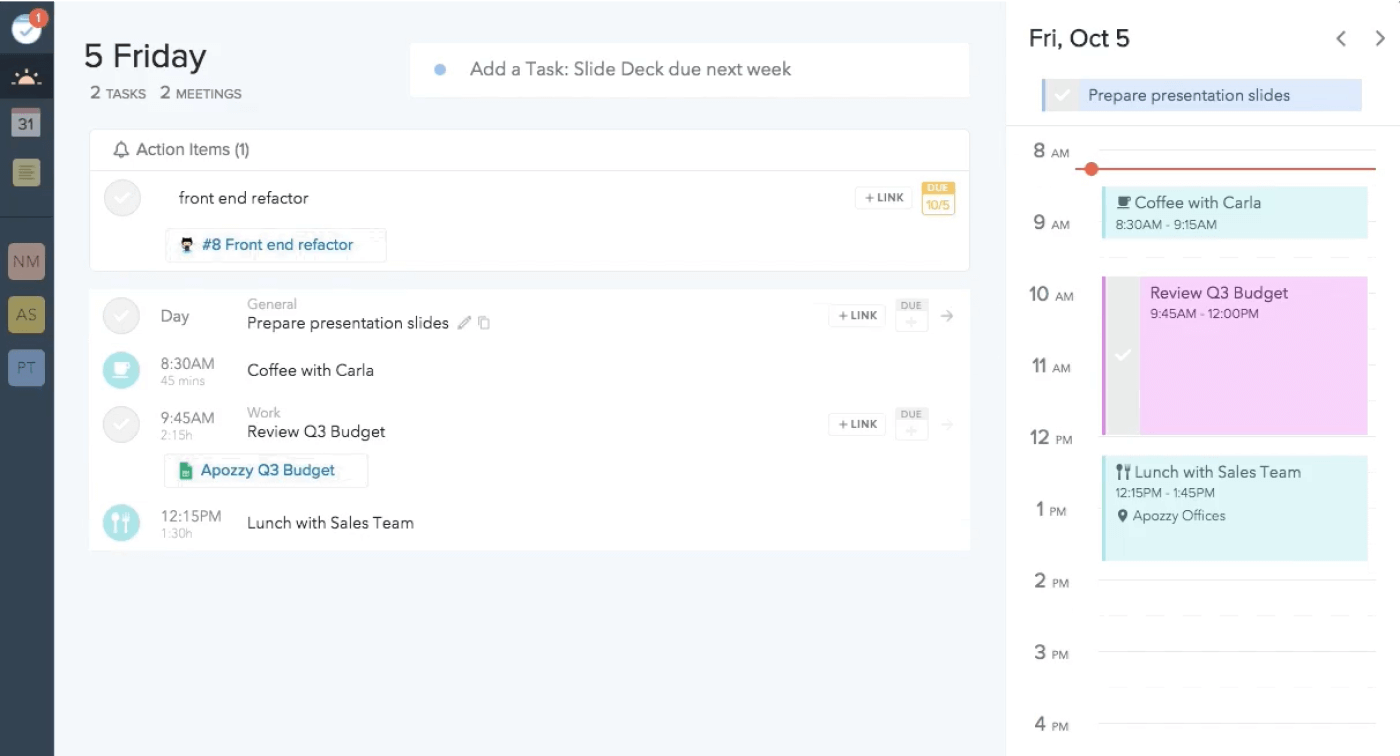
Best for: simple task organization and calendar syncing.
Unique Features: Plan offers a straightforward interface ideal for users who want minimalism in their productivity tools. Its dashboard provides insights into your activities, including monthly meetings, time spent on similar tasks, and location tracking.
Integrations: syncs with Google Calendar and Outlook, making it easy to integrate your existing commitments and streamline your schedule.
Drawbacks: limited to-do list functionality; may not meet the needs of users requiring advanced project management capabilities.
Sunsama

Best for: daily personal planning with a focus on work-life balance.
Unique Features: Sunsama is designed to help users organize daily tasks for a balanced lifestyle. The app allows you to drag and drop tasks into your calendar, making it easy to create a realistic daily plan.
Integrations: syncs with popular tools such as Trello, Gmail, Asana, Jira, and Slack.
Drawbacks: while excellent for daily planning, Sunsama may not suit users who need more advanced features for complex project management.
TickTick
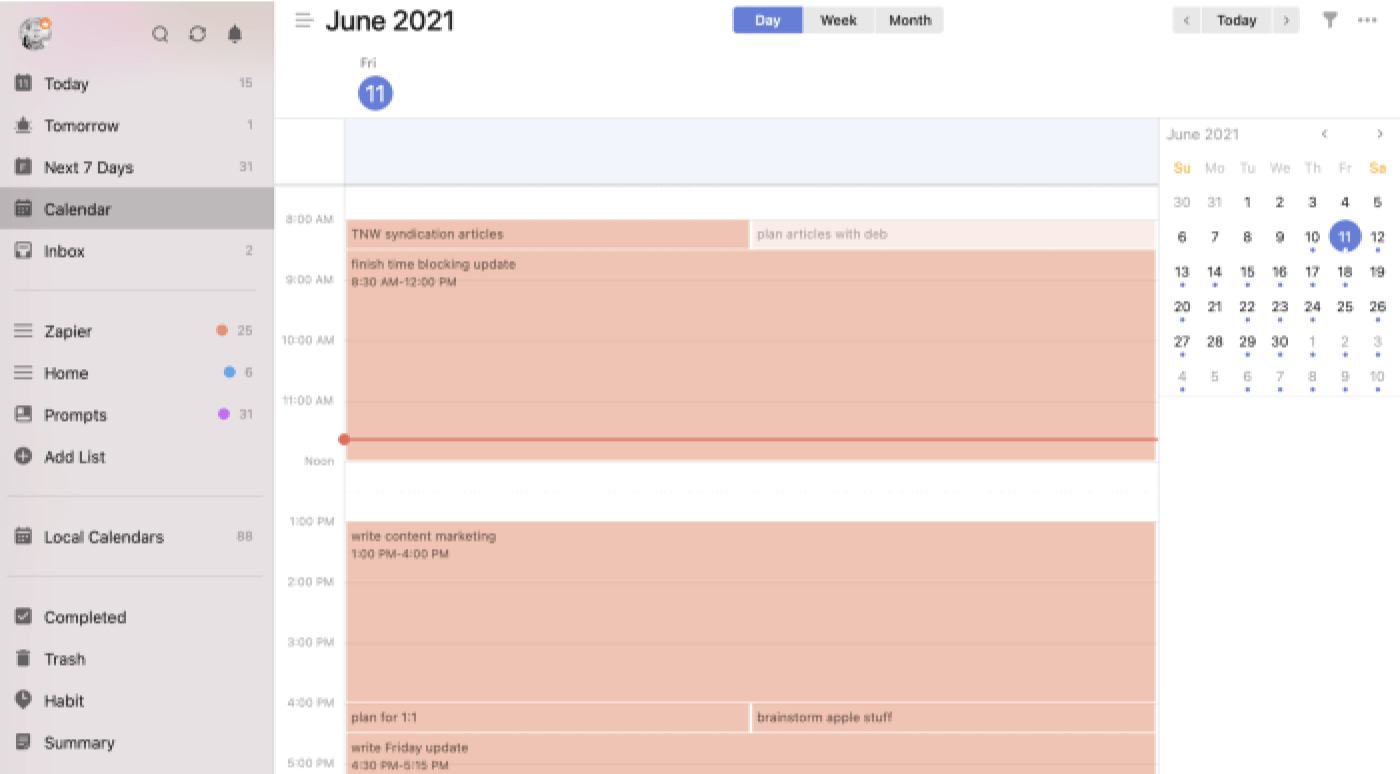
Best for: customizable to-do lists and on-the-go task management.
Unique Features: TickTick excels at quick task additions, allowing users to create tasks through voice input, Siri, or widgets. Its smart lists, such as "Today" and "Tomorrow," help organize tasks automatically, while features like multiple reminders, Pomodoro timers, and historical statistics make it a powerful productivity tool.
Integrations: supports integration with Google Calendar, Siri, and other tools.
Drawbacks: the app may feel overly feature-rich for users looking for simpler time-blocking solutions.
HourStack
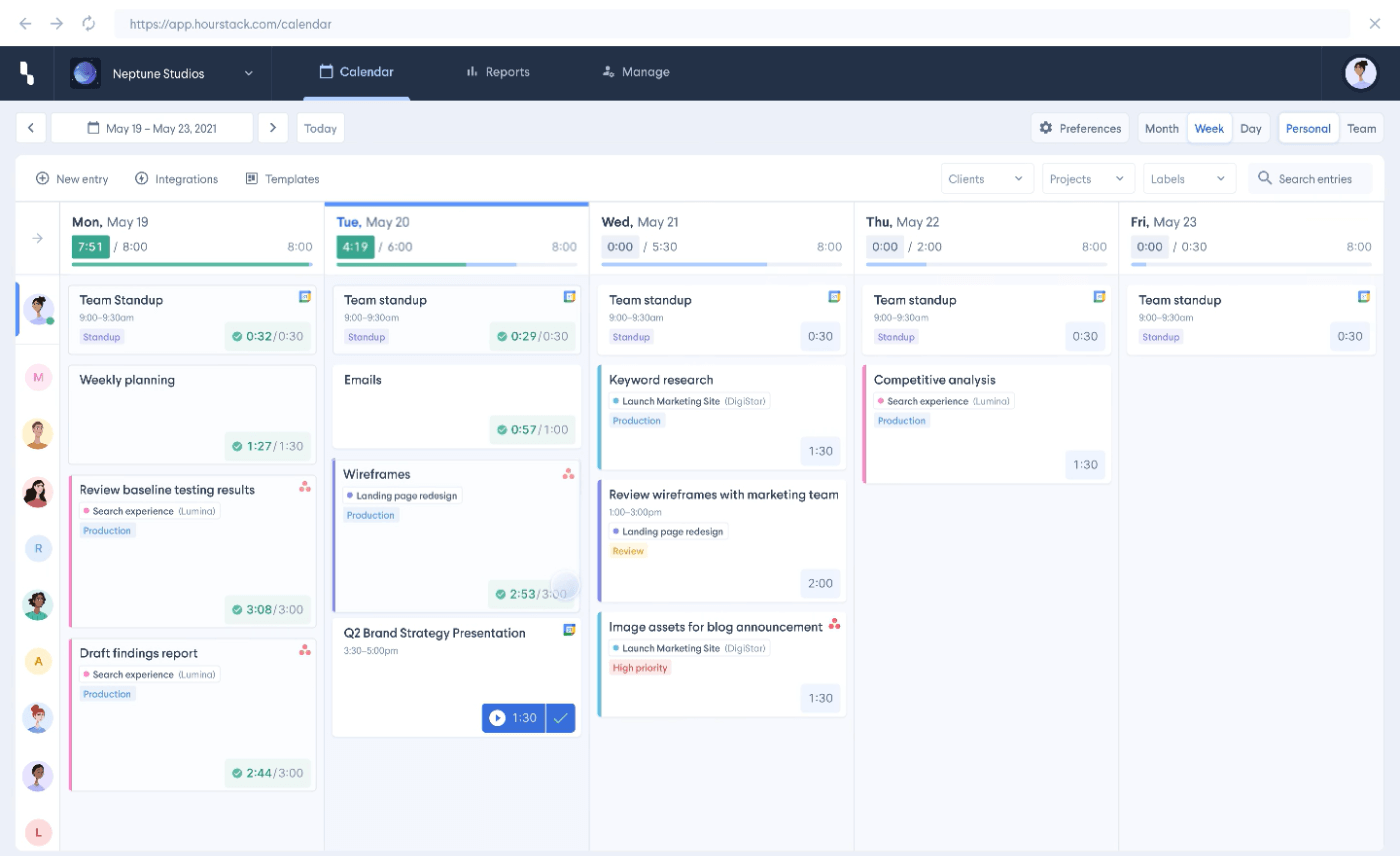
Best for: professionals and teams seeking to analyze and optimize their time usage through visual planning and detailed reporting.
Unique Features: incorporates a built-in timer to monitor time spent on tasks, aiding in identifying productivity patterns. Generates insightful reports comparing planned versus actual time spent, helping to pinpoint inefficiencies.
Integrations: seamlessly connects with various tools, including Google Calendar, Slack, GitHub, and HubSpot, to streamline workflows.
Drawbacks: the absence of a mobile app may limit accessibility for users who prefer managing tasks on the go.
Todoist
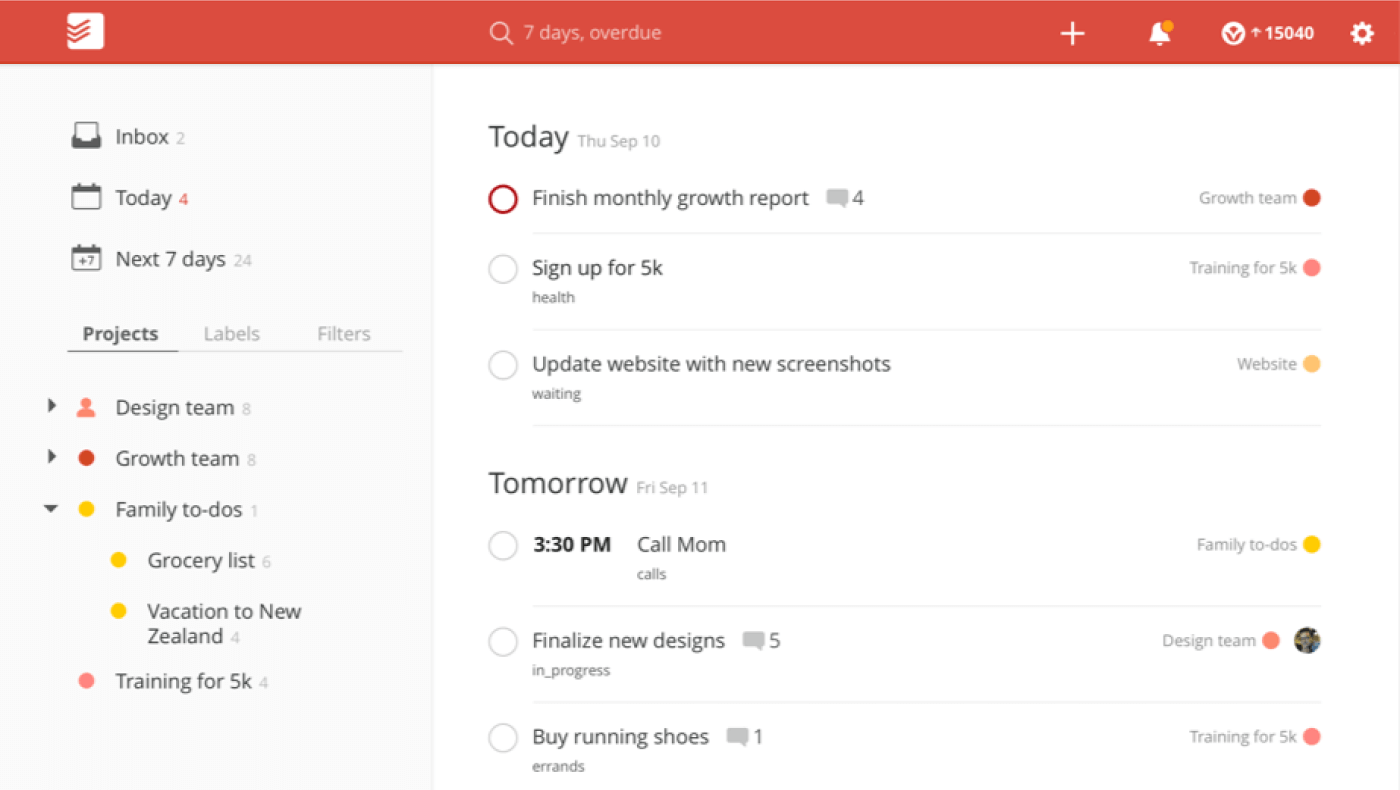
Best for: individuals and teams seeking a straightforward yet powerful to-do list app with robust task management features.
Unique Features: monitor progress with visualizations like the "Karma" score, which rewards task completion and encourages consistent productivity. Available with paid plans, Todoist’s AI Assistant can provide tips, suggest tasks, and break down complex tasks into more manageable pieces.
Integrations: connects with over 80 applications, including Google Calendar, Slack, and Dropbox, to streamline workflows and centralize task management.
Drawbacks: while Todoist offers a free version, some basic features like reminders and labels are limited to premium subscribers.
TimeBloc
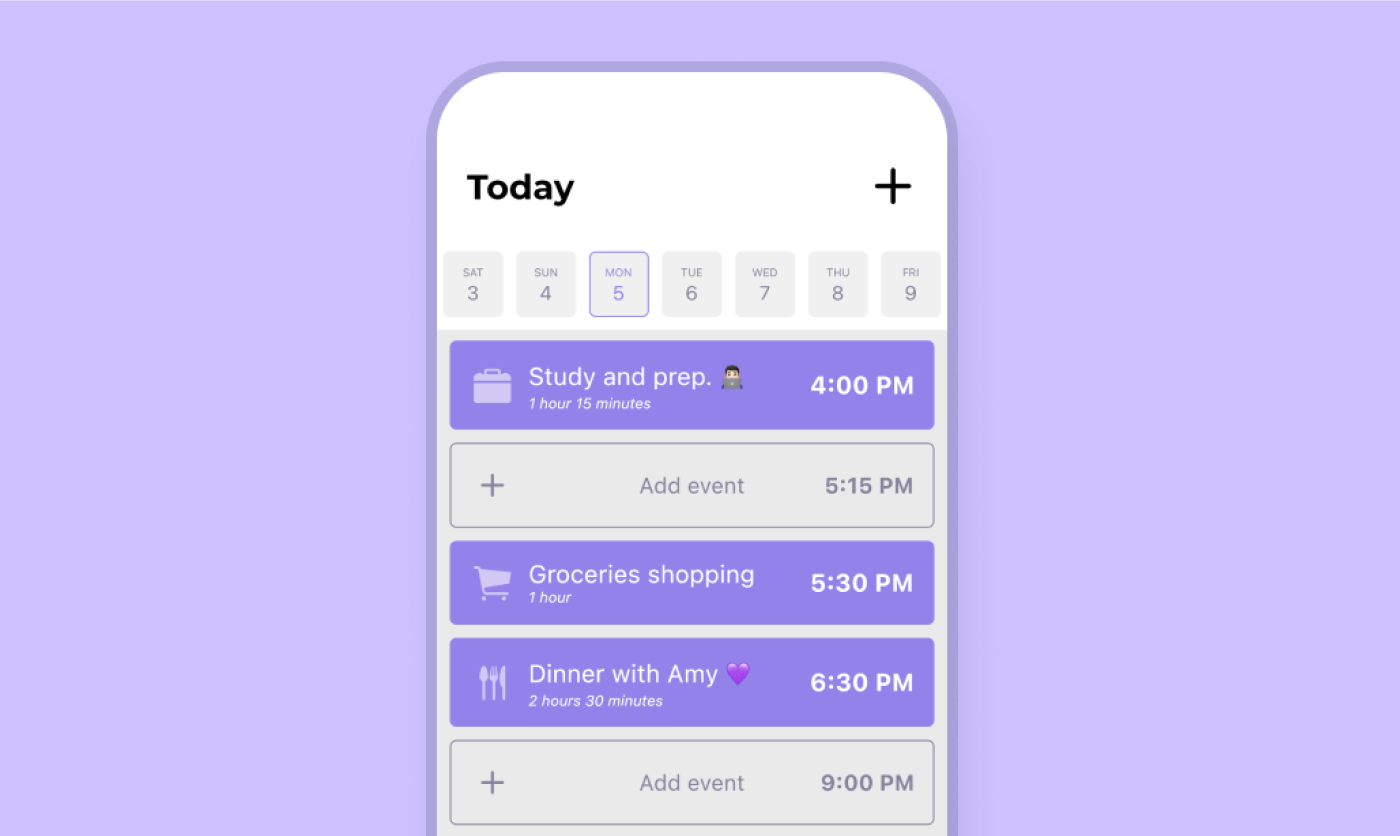
Best for: mobile users looking for intuitive, block-based time scheduling.
Unique Features: features include the ability to create daily routines with recurrences, add colored tags and icons for easy identification of tasks, and visualize progress over time.
Integrations: integrates with popular calendar platforms like Google Calendar and Apple Calendar, enabling users to sync their existing schedules seamlessly.
Drawbacks: lacks a desktop version, which may limit its usability for users who prefer managing tasks on larger screens. Additionally, its features are primarily focused on personal time management rather than team collaboration.
Google Calendar

Best for: users seeking a free, accessible, and widely compatible scheduling solution for personal and professional use.
Unique Features: provides intuitive calendar views (daily, weekly, and monthly) with the ability to create and manage events quickly. Automatically adds events from Gmail, such as flights, reservations, and meetings.
Integrations: seamlessly integrates with Google Workspace apps (Gmail, Google Meet, Drive) and numerous third-party tools, making it highly versatile across platforms.
Drawbacks: while it offers excellent basic functionality, advanced time-blocking features like deep work scheduling or task prioritization are limited compared to specialized apps.
Any.do
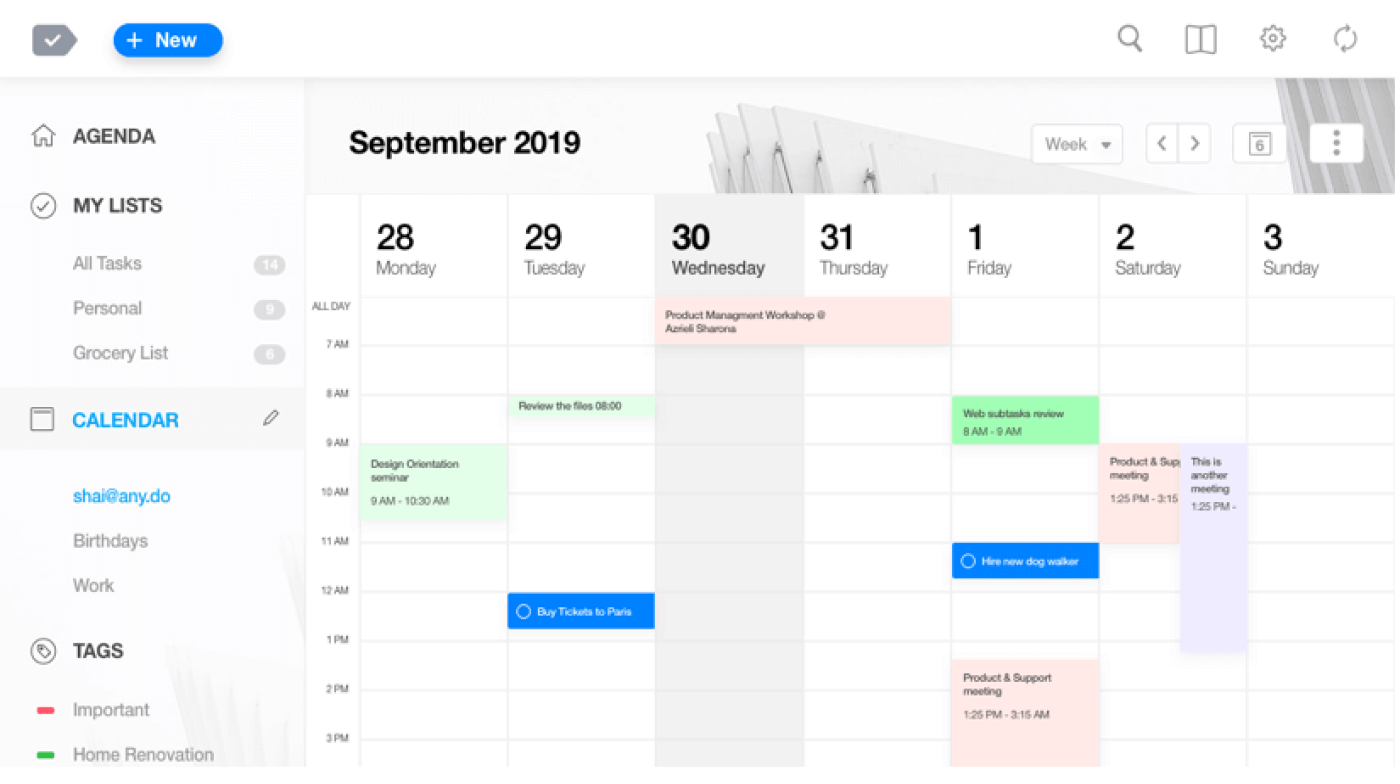
Best for: users seeking a simple and intuitive app for personal task management with collaboration capabilities.
Unique Features: allows tasks to be added via voice input or converted from emails for on-the-go productivity.
Integrations: works with Google Calendar, Outlook, and Alexa, along with tools like WhatsApp for managing tasks seamlessly across platforms.
Drawbacks: advanced collaboration features are limited in the free version, and the app may lack the depth needed for complex project management or detailed time tracking.
ClickUp
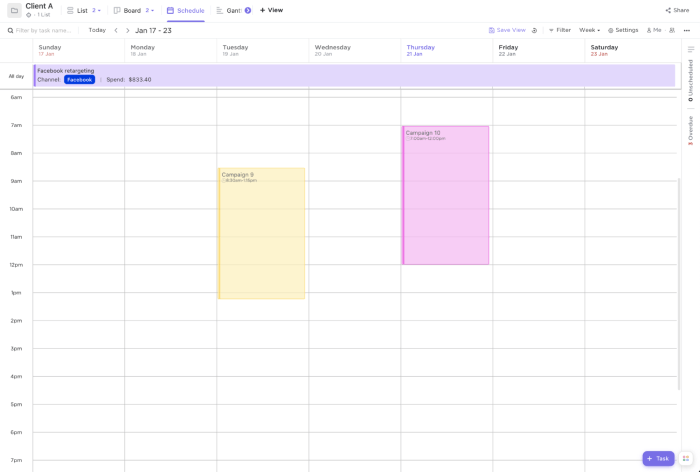
Best for: teams and individuals seeking a highly customizable project management tool that integrates task management, time tracking, and collaboration features.
Unique Features: enables the creation of custom statuses, fields, and priorities to tailor workflows to specific project needs.
Integrations: Connects with over 1,000 tools, including Slack, Google Drive, and GitHub, facilitating seamless integration into existing workflows.
Drawbacks: The extensive range of features may present a learning curve for new users.
Clockify
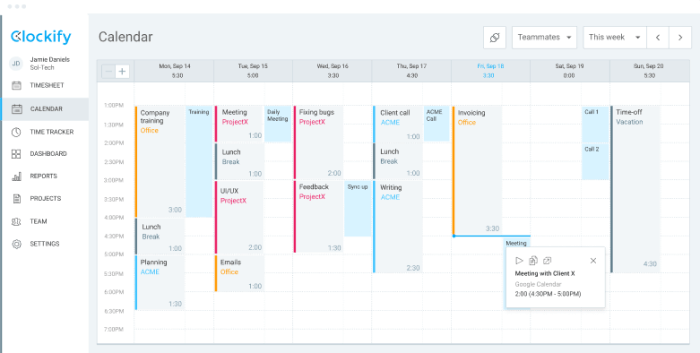
Best for: individuals and teams seeking a dedicated time tracking tool to monitor productivity and manage billable hours.
Unique Features: generates insightful reports that break down time usage by project, task, or team member, aiding in productivity analysis.
Integrations: seamlessly integrates with over 80 web applications, including project management tools like Trello, Asana, and Jira, as well as communication platforms like Slack and Microsoft Teams.
Drawbacks: the interface may feel overwhelming to new users due to its extensive feature set.
TimeCamp
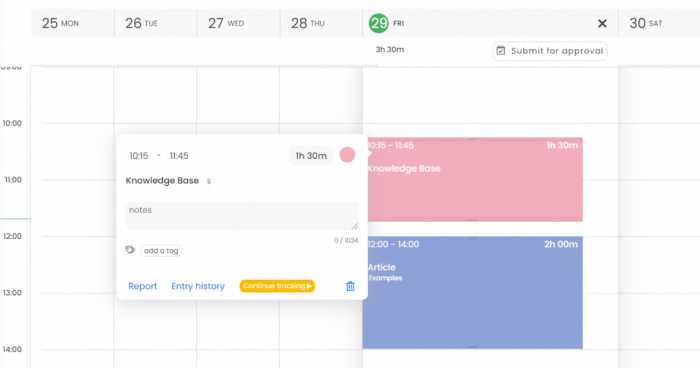
Best for: professionals and teams seeking a comprehensive time tracking solution with robust reporting and integration capabilities.
Unique Features: TimeCamp offers automatic time tracking, capturing time spent on various applications and websites without manual input. Includes features for tracking attendance, managing timesheets, and monitoring productivity.
Integrations: TimeCamp integrates with over 100 tools, including project management platforms like Asana, Trello, and ClickUp, as well as communication tools like Slack and Microsoft Teams.
Drawbacks: the extensive feature set may require a learning curve for new users.
TogglTrack
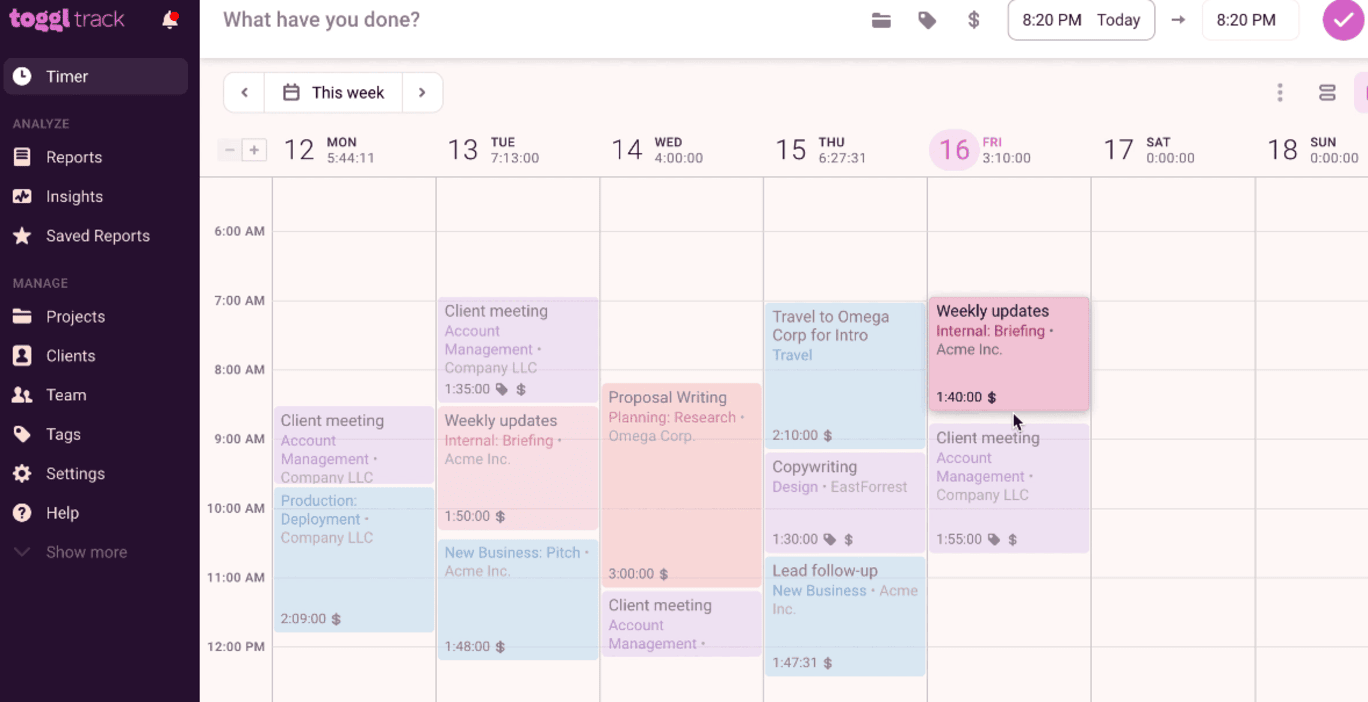
Best for: individuals and teams seeking a user-friendly time tracking tool with robust reporting and integration capabilities.
Unique Features: enables users to set project budgets, track progress, and monitor billable versus non-billable hours.
Integrations: seamlessly integrates with over 100 web applications, including project management tools like Asana, Trello, and Jira, as well as communication platforms like Slack and Microsoft Teams.
Drawbacks: the interface may feel overwhelming to new users due to its extensive feature set.
Fantastical

Best for: Mac and iOS users seeking an elegant and feature-rich calendar and task management application.
Unique Features: allows users to create events and reminders using simple, natural language input, streamlining the scheduling process.
Integrations: supports integration with various calendar services such as iCloud, Google, Exchange, Office 365, Todoist, and Google Tasks, enabling seamless synchronization across platforms.
Drawbacks: while Fantastical offers a free version with basic features, access to advanced functionalities like collaboration tools and extended weather forecasts requires a subscription to Flexibits Premium.
Motion
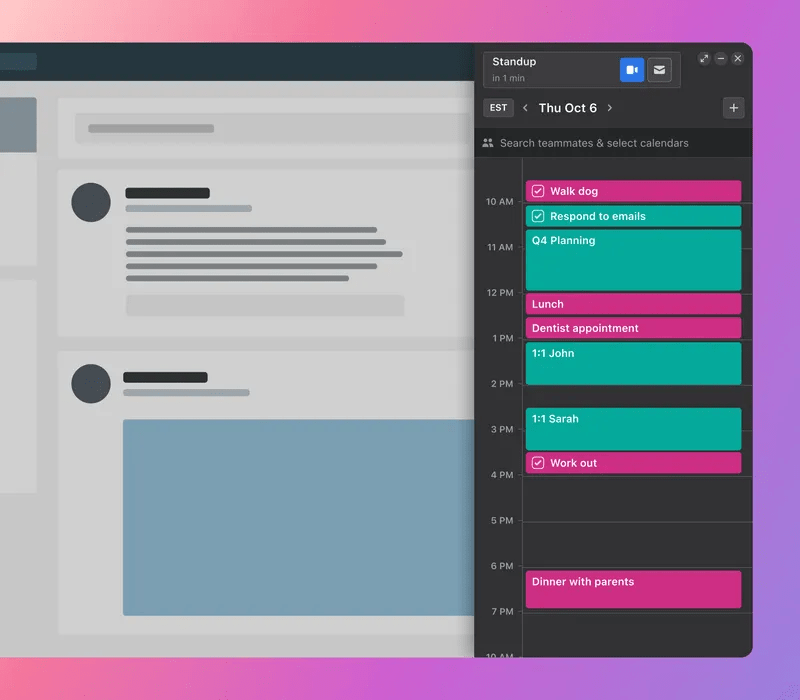
Best for: professionals and teams seeking an AI-driven productivity tool that integrates task management, calendar scheduling, and project planning to optimize daily workflows.
Unique Features: automatically prioritizes tasks and dynamically time-blocks them on your calendar, adjusting in real-time to changes and ensuring an up-to-date plan.
Integrations: seamlessly integrates with external calendars such as Google Calendar and iCloud, as well as tools like Siri for voice-activated task creation.
Drawbacks: the AI-driven approach may necessitate an adjustment period for users accustomed to manual scheduling.
Clockwise

Best for: teams and individuals aiming to optimize their schedules by maximizing focus time and minimizing meeting conflicts through intelligent calendar management.
Unique Features: Clockwise analyzes your calendar to automatically move flexible meetings, creating uninterrupted blocks of focus time. Identifies and protects periods for deep work by rearranging meetings and reducing calendar fragmentation.
Integrations: seamlessly integrates with Google Calendar and Microsoft Outlook, as well as productivity tools like Slack and Asana, enhancing workflow efficiency.
Drawbacks: the effectiveness of its AI-driven scheduling may vary depending on the flexibility of existing meetings and organizational culture.
Selecting the right app for you
When choosing a time-blocking app, consider your unique productivity style. If deep work is a priority, tools with strong focus features like Pomodoro timers (e.g., TickTick) or Focus Time (e.g., Clockwise) might be ideal. For seamless collaboration, apps with extensive integrations like Planyway or Sunsama will help maintain visibility across team projects.
How to start time blocking?
Are you ready to give it a try but not sure what to start with? We’ve made a list of seven key steps, so you can take charge of your calendar and get valuable results straight away:
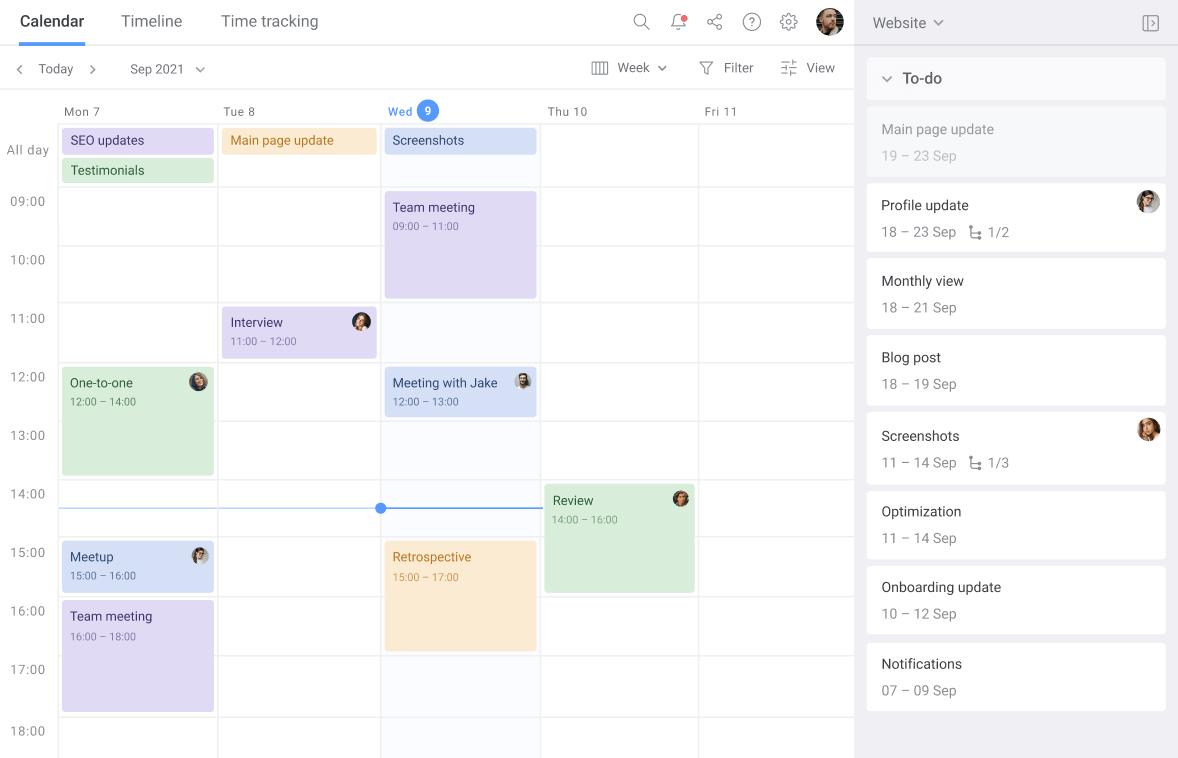
Step 1. Identify what you need to work on
No matter what time management technique you use, the first step you should take is to identify what you need to get done on a given day or week. Make a list of your to-dos and prioritize them all based on how important they are. Prioritization will grant you a clear understanding of which tasks should be completed today and which ones you can finish later.
Step 2. Define your most productive time
You can significantly improve productivity by scheduling your daily activities according to periods when you have the most or the least energy. Are you more productive in the morning? Then, consider it for tasks requiring more focus. Feel sleepy in the afternoon? Deal with smaller tasks like emails. Have a second wind in the late afternoon? Work on important tasks and try to minimize distractions so that they can’t interrupt your workflow.
Step 3. Block off personal time
Time blocking is not just about scheduling work, it’s also about scheduling your free time. No need to plan it by minutes, just create time blocks for personal activities to easily stick to them and at the same time restrict your working hours.
Step 4. Group meetings
The problem about meetings is that they’re scattered throughout the day which makes it unbelievably hard to switch contexts and return to work again. Instead of being interrupted, aim for a block of meetings, so you have them scheduled close to each other.
Step 5. Schedule tasks with time blocks
Once you know when you’re most and least productive, it’s time to schedule work on the calendar. Think of the priority you set before and allocate tasks to your time slots accordingly. It’s also absolutely fine if you want to come back to tasks more than once a day, e.g. replying to emails. Just plan it out in advance.
Step 6. Plan breaks
Schedule breaks beforehand, so you have a more truthful picture of your day. Find time not just for lunch but also for a quick stretch or walk to give your brain a rest — quality leisure time is highly important.
Step 7. Allow interruptions
Time blocking will eventually fail if there is no room for unexpected tasks during the day that has to be done asap. Of course, you don’t want them to totally destroy your plan but still, it’s important to engage. If this is a frequent situation, we recommend dedicating a special block with flexible time.
Why is time blocking helpful?
Now let’s see how exactly time blocking calendar makes your life more productive:
It prompts deep work
Deep work means the ability to concentrate on a cognitively demanding task with no distraction. When you have a certain time booked to work on a specific task, you focus all your attention on one thing rather than spreading it across several tasks and cut off all distracting factors. Deep work will make you better at what you do and provide a sense of true fulfillment in the end.
It helps you reduce shallow work
Shallow work is the term that describes urgent but not very important tasks like paperwork, emails, chat messages, etc. The time blocking method allows you to set clear limits on how much time you can spend on this kind of work per day. You can group shallow tasks in one or several dedicated time blocks to manage them all together so that you can reduce the context switching from higher-impact work.
It makes you realistic about how you spend time
It’s not an easy job to predict how much time a task will take. In general, we tend to underestimate our efforts and then get into a situation when we don’t have enough time to accomplish a task. Blocking physical space on your calendar makes you far more aware of how much time you need to do a certain type of work. Then, when you do similar work next time, you can refer to your previous experience and make more accurate estimations.
It counteracts perfectionism
The main problem of any perfectionist is that there is always a place for improvement. If you often prolong tasks because of trying to get everything just perfect, imposing limits can help you say “good enough” and move on.
It helps you achieve your goals
Having a concrete plan of action will help you walk through towards your goals much faster. By scheduling time blocks you can take a step forward every single day and make your plan of action come to life to reach your final goal quicker.
Common mistakes in time-blocking
Now when advantages are uncovered, it’s also important to be aware of the traps that may show up on your way. Here’re the most common mistakes people make when they’re just setting up and some tips to avoid them:
Mistake 1. Underestimating task time
Avoid cramming too much into your schedule. Time blocking is most effective with realistic estimates.
Mistake 2. Lack of flexibility
Allow room for interruptions, especially if you work in a dynamic environment.
Mistake 3. Overscheduling non-working hours
Over-planning free time can reduce enjoyment. Instead, set flexible blocks to unwind without rigid scheduling.
Final thoughts
Time blocking is a powerful tool for deep work productivity and effective task management, whether in personal or professional settings. Choosing the best productivity app depends on your goals — whether it’s tracking time spent on tasks, maintaining focus, or balancing work and personal life.
This guide has highlighted the best options to help you start your time-blocking journey. Experiment with a few to see which suits your needs, and remember to adapt your schedule as your productivity habits evolve.


